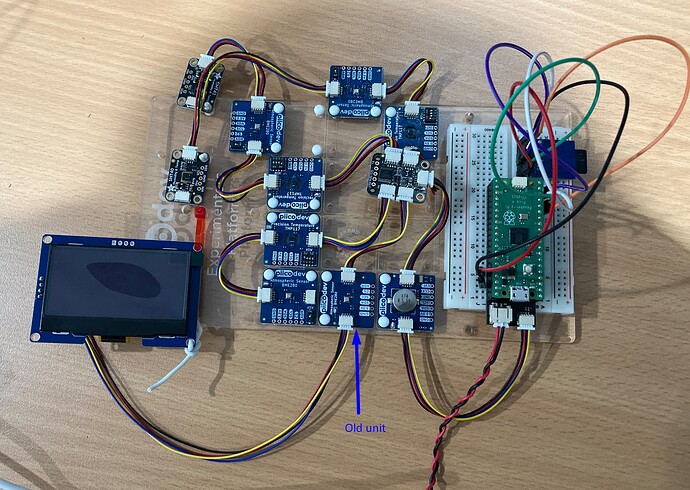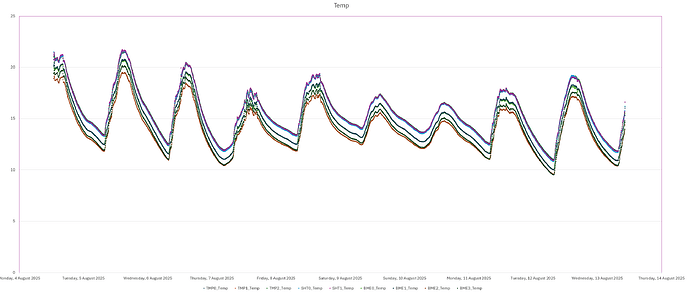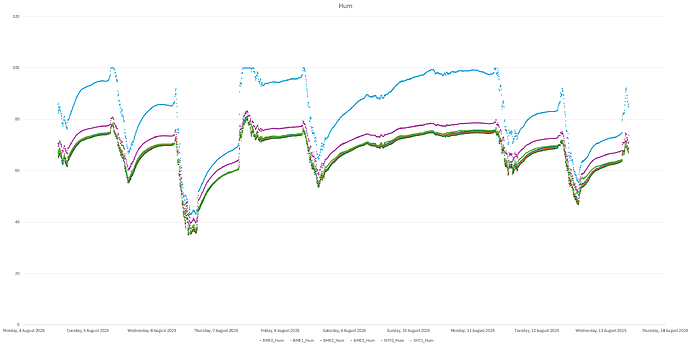Hi @Zach
Thanks for that info. I will give the boards a dry bake followed by an ambient rehydration when the “heating equipment” is free. Since they are not working I guess there is nothing to lose.
Hi Fractal,
Just make sure there isn’t an exposed element radiating directly onto it, and that there is forced convection.
Without both there is a high chance the plastic begins to melt
Thanks @Liam, @Fractal, @Zach, and @Liam120347
Some really great info there! @Fractal’s comments got me thinking about my own setup. I’ve been recording data from the BME280 and a precision temperature TMP117 every 2 seconds for over a year and I figured it would be worth comparing the data. I aggregated the data back to 1 minute averages over 8 months (February to October: ~300,000 paired data points) and had a look at the discrepancy (Both sensors were connected to the same RPi4B, daisy chained through I2C - so roughly 10 cm from each other and the pi).
The results were interesting! It seems like the two sensors give fairly similar results (Fig 1A), with the TMP117 being consistently warmer (BM280 had a median discrepancy of -0.529 deg C; Fig 1B). However the discrepancy of BME280 wasn’t distributed evenly across the temperature range of the TMP117. It seems that the difference between the sensors is highest at cooler temperatures, becoming almost identical as they both approach 35 to 40 deg C (Fig 1C). Looking at the discrepancy as a percentage of the TMP117, it seems the difference is at its worst around 10 to 15 deg C, where the BME280 approaches an error of 15% cooler (Fig 1D).
Figure 1 Temperature discrepancies between BME280 and TMP117
I also checked how the sensor discrepancy changed over time, to see if there was any degradation of the sensors. I couldn’t detect any change over the 8 month period that looked like sensor decay (Fig 2). The noise at the very beginning is interesting though. I suspect that is do with Perth WA having its driest ever 8 month period (October 2023 to end of April 2024). I’m not implying the sensors are being effected differently by drought, rather I suspect the reticulation system being used ~5m from the sensors during that period probably caused all sorts of fluctuations in temperature and humidity (Trying to save the garden!).
Figure 2 Changes to temperature discrepancy over time
Now obviously there’s a tonne of caveats to this kind of analysis, particularly in the way the sensors were setup. Both were openly exposed in a covered but outdoor area, and no care was taken to ensure the boards had adequate airflow, were out of direct sunlight, and weren’t receiving radiant/reflectant heat.
All in all, I’m not sure which board is more correct, or even if either are. Certainly I think the components likely have very different rates of heat output and thermal conductivity, and considering the BME280 is only rated to +/- 1 deg C, I’m pretty happy that they record very similarly. I’d love to compare these results to a more accurate sensor, and get a better feel for their overall accuracy.
Hope that helps,
Cam
As a follow up to the above I tried the Bosch BME280 reconditioning procedure to restore the humidity sensor to the calibration state. This involved:
- Dry-Baking 120 degC at <5% rH for 2 h
- Re-Hydration 25 degC at 75% rH for 24 h
This was not easy. My reconditioning instrument had sophisticated controls like “fan bake” but no humidity setting.
Fortunately with the current weather my office was close to 25 degC and 75% humidity for re-hydration.
When powered up the first BME280 gave completely erratic readings (taken every 5 mins) and then after 5 hours it quickly returned to 100% humidity where it stayed.
I had better luck with the second unit which worked for 38 hours but then after hitting 100% humidity it saturated and stayed there.
Looks like both are destroyed.
So still looking for a good humidity sensor. My research shows that pro units have heaters to remove condensation.
I have run a 1-wire weather station for around 15 years and I have found the Honeywell HIH-3610 and HIH-4000 sensors to be long term reliable and to recover well from extended periods of very high humidity. I don’t think they can be called high end sensors but they seem to do the job.
Ian
Hi All,
Sorry about the delay in updates, moving warehouse put quite a few projects on the backburner.
I’ve got a test-setup running now, 3 x TMP’s, 3 x BME’s (one being the oldest I could find from our on hand kit), and an SHT40 + SHT41 (much better sentiment around the net).
All of the other sensors are straight from stock, with the last production run being completed in January this year.
I didn’t want to revive other topics, but this reply from @Oliver33 got me thinking:
These sensors are likely used inside other Bosch units (dishwashers, washing machines etc) where the compartment its located in does not require a super super accurate temperature measurement.
The Nano Power Timer is set for a 10 minute interval.
Once a month or two have passed I’ll circle back, upload the measurements.
Regardless, I propose a couple of fixes depending on the outcome of my test and everyone’s observations:
- Rework the driver to include an offset based on a combination of our data.
- Develop a new module around another sensor, the SHT4x series looks good at a glance
Does the lack of pressure sensor deter anyone from purchasing these modules?
PS: please let me know if you like the look of the platform its all mounted on.
Liam
Hey All,
Circled back to make sure the data being captured was usable.
So far…
Temperature
The temperature graph looks pretty consistent, all readings seem to have some noise, are time invariant (no easily observable drift, given its only been a week), and BME readings might be able to be corrected with a scale and offset factor (y=mx+b).
But it is very clear that the temperature sensor is not as accurate as the SHT or TMP’s.
Humidity
Much the same as temperature, no drift coming into play yet… but interestingly the SHT40 has a larger difference right now compared to the new BME280’s.
etc etc
I’ll also add some DHT22’s - DHT22 Module (Temperature and Humidity) | Buy in Australia | CE09581 | Core Electronics
Keen to hear everyone’s thoughts!
Liam





